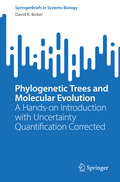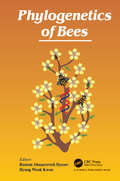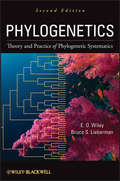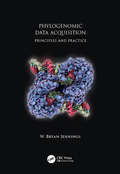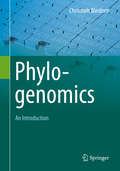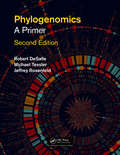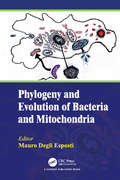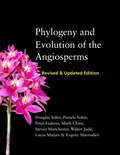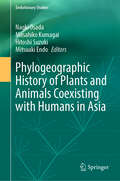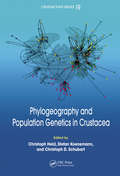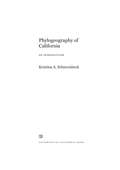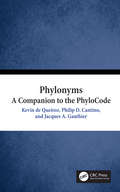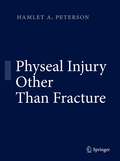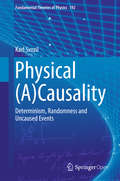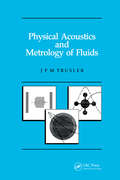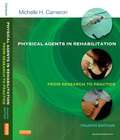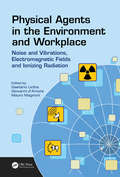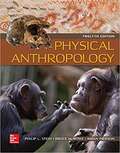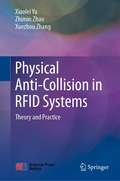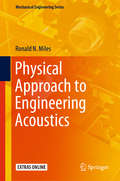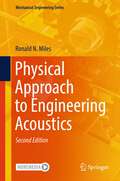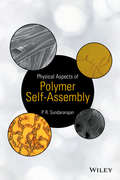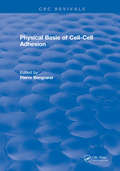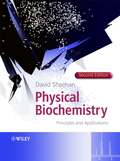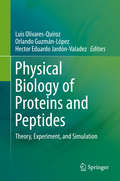- Table View
- List View
Phylogenetic Trees and Molecular Evolution: A Hands-on Introduction with Uncertainty Quantification Corrected (SpringerBriefs in Systems Biology)
by David R. BickelThis book serves as a brief introduction to phylogenetic trees and molecular evolution for biologists and biology students. It does so by presenting the main concepts in a variety of ways: first visually, then in a history, next in a dice game, and finally in simple equations. The content is primarily designed to introduce upper-level undergraduate and graduate students of biology to phylogenetic tree reconstruction and the underlying models of molecular evolution. A unique feature also of interest to experienced researchers is the emphasis on simple ways to quantify the uncertainty in the results more fully than is possible with standard methods.
Phylogenetics of Bees
by Rustem Abuzarovich Ilyasov Hyung Wook KwonBees are flying insects of the order Hymenoptera closely related to wasps and ants. The ancestors of bees are assumed to be predatory wasps, which switched to pollen consumption. Further, bees co-evolved with flowering plants and divided into several species according to climatic conditions. Widely known bees are western bees Apis mellifera, and eastern bees Apis cerana. This book sheds light on features of evolution, phylogenesis, speciation, adaptation to environment, and taxonomy of bees. It will be of particular relevance to evolutionists, geneticists, taxonomists, ecologists, population geneticist, and breeders.
Phylogenetics: Theory and Practice of Phylogenetic Systematics
by Bruce S. Lieberman E. O. WileyThe long-awaited revision of the industry standard on phylogenetics Since the publication of the first edition of this landmark volume more than twenty-five years ago, phylogenetic systematics has taken its place as the dominant paradigm of systematic biology. It has profoundly influenced the way scientists study evolution, and has seen many theoretical and technical advances as the field has continued to grow. It goes almost without saying that the next twenty-five years of phylogenetic research will prove as fascinating as the first, with many exciting developments yet to come. This new edition of Phylogenetics captures the very essence of this rapidly evolving discipline. Written for the practicing systematist and phylogeneticist, it addresses both the philosophical and technical issues of the field, as well as surveys general practices in taxonomy. Major sections of the book deal with the nature of species and higher taxa, homology and characters, trees and tree graphs, and biogeography—the purpose being to develop biologically relevant species, character, tree, and biogeographic concepts that can be applied fruitfully to phylogenetics. The book then turns its focus to phylogenetic trees, including an in-depth guide to tree-building algorithms. Additional coverage includes: Parsimony and parsimony analysis Parametric phylogenetics including maximum likelihood and Bayesian approaches Phylogenetic classification Critiques of evolutionary taxonomy, phenetics, and transformed cladistics Specimen selection, field collecting, and curating Systematic publication and the rules of nomenclature Providing a thorough synthesis of the field, this important update to Phylogenetics is essential for students and researchers in the areas of evolutionary biology, molecular evolution, genetics and evolutionary genetics, paleontology, physical anthropology, and zoology.
Phylogenomic Data Acquisition: Principles and Practice
by W. Bryan JenningsPhylogenomics is a rapidly growing field of study concerned with using genome-wide data—usually in the form of DNA sequence loci—to infer the evolution of genes, genomes, and the Tree of Life. Accordingly, this discipline connects many areas in biology including molecular and genomic evolution, systems biology, molecular systematics, phylogeography, conservation genetics, DNA barcoding, and others. With the advent of Next Generation Sequencing in addition to advances in computer hardware and software over the past decade, researchers can now generate unparalleled phylogenomic datasets that are helping to illuminate many areas in the life sciences. This book is an introduction to the principles and practices of gathering these data. Phylogenomic Data Acquisition: Principles and Practice is intended for a broad cross-section of biologists and anyone else interested in learning how to obtain phylogenomic data using the latest methods.
Phylogenomics
by Christoph BleidornThis unique textbook provides a clear and concise overview of the key principles of the complex field of phylogenomics, with a particular focus on sequencing technologies that are crucial to studying and understanding interrelations in evolutionary genomics. It includes chapters dedicated to the analysis of nucleotide sequences using assembling and alignment methods and also discusses the main strategies for phylogenetic studies, systematic errors and their correction. This highly readable textbook is intended for graduate students and young researchers with an interest in phylogenetics and evolutionary developmental biology.
Phylogenomics: A Primer
by Rob DeSalle Jeffrey Rosenfeld Michael TesslerPhylogenomics: A Primer, Second Edition is for advanced undergraduate and graduate biology students studying molecular biology, comparative biology, evolution, genomics, and biodiversity. This book explains the essential concepts underlying the storage and manipulation of genomics level data, construction of phylogenetic trees, population genetics, natural selection, the tree of life, DNA barcoding, and metagenomics. The inclusion of problem-solving exercises in each chapter provides students with a solid grasp of the important molecular and evolutionary questions facing modern biologists as well as the tools needed to answer them.
Phylogeny and Evolution of Bacteria and Mitochondria
by Mauro Degli EspostiLife on earth began with bacteria, which now colonize every corner of the planet. As the ancestors of mitochondria, bacteria are also fundamental for our cells. Most bacteria look alike, but have very different functions. Therefore, knowing the functional profile of bacteria helps understand their impact on our life. This book provides a wealth of information on the functional evolution of bacteria in a novel and coherent way. The book is aimed towards scientists as well as those who are curious about the world of bacteria and their relationships with mitochondria, the powerhouses of our cells, and us.
Phylogeny and Evolution of the Angiosperms: Revised and Updated Edition
by Steven Manchester Douglas Soltis Pamela Soltis Peter Endress Mark W. Chase Walter Judd Lucas Majure Evgeny MavrodievAlthough they are relative latecomers on the evolutionary scene, having emerged only 135‒170 million years ago, angiosperms—or flowering plants—are the most diverse and species-rich group of seed-producing land plants, comprising more than 15,000 genera and over 350,000 species. Not only are they a model group for studying the patterns and processes of evolutionary diversification, they also play major roles in our economy, diet, and courtship rituals, producing our fruits, legumes, and grains, not to mention the flowers in our Valentine’s bouquets. They are also crucial ecologically, dominating most terrestrial and some aquatic landscapes. This fully revised edition of Phylogeny and Evolution of the Angiosperms provides an up-to-date, comprehensive overview of the evolution of and relationships among these vital plants. Incorporating molecular phylogenetics with morphological, chemical, developmental, and paleobotanical data, as well as presenting a more detailed account of early angiosperm fossils and important fossil information for each evolutionary branch of the angiosperms, the new edition integrates fossil evidence into a robust phylogenetic framework. Featuring a wealth of new color images, this highly synthetic work further reevaluates long-held evolutionary hypotheses related to flowering plants and will be an essential reference for botanists, plant systematists, and evolutionary biologists alike.
Phylogeographic History of Plants and Animals Coexisting with Humans in Asia (Evolutionary Studies)
by Hitoshi Suzuki Naoki Osada Masahiko Kumagai Mitsuaki EndoThis book offers a comprehensive understanding of the natural history of the Japanese Archipelago (Yaponesia), employing cutting-edge genomic research to provide insights into the prehistory in this region. It provides an in-depth exploration of the genetic makeup of domesticated plants and animals in the Japanese Archipelago, including their relationships with neighboring regions in Asia. The book is unique in its comprehensive approach, weaving together the latest genomic research, historical records, and linguistic analysis to provide a detailed understanding of the past. The book covers the development of Japanese society and culture from the Jomon era to the present day. It discusses the animal and plant diversity of the country, including their distribution, evolution, and interaction with human society and culture. The linguistic distributions of related terms are also explored. Using the latest genomic research, the book offers a fresh perspective on the past and present of the Japanese Archipelago, providing a comprehensive understanding of the natural and cultural history of the Japanese Archipelago. It is a valuable resource for professionals and academics in genomics, archaeology, and linguistics, as well as general readers interested in Japanese history, culture, and the environment.
Phylogeography and Population Genetics in Crustacea
by Stefan Koenemann Christoph Held Christoph D. SchubartRecently, technological progress and the rise of DNA barcoding efforts have led to a significant increase in the availability of molecular datasets on intraspecific variability. Carcinologists and other organismal biologists, who want to use molecular tools to investigate patterns on the scale of populations, face a bewildering variety of genetic m
Phylogeography of California
by Kristina A. SchierenbeckPhylogeography of California examines the evolution of a variety of taxa--ancient and recent, native and migratory--to elucidate evolutionary events both major and minor that shaped the distribution, radiation, and speciation of the biota of California. The book also interprets evolutionary history in a geological context and reviews new and emerging phylogeographic patterns. Focusing on a region that is defined by physical and political boundaries, Kristina A. Schierenbeck provides a phylogeographic survey of California's diverse flora and fauna according to their major organismal groups. Life history and ecological characteristics, which play prominent roles in the various outcomes for respective clades, are also considered throughout the work. Supporting scholars and researchers who study evolutionary diversification, the book analyzes research that helps assess one of the major challenges in phylogeographic studies: understanding changes in population structures shaped by geological and geographical processes. California is one of only twenty-five acknowledged biological hotspots worldwide, and the phylogeographic history of the state can be extrapolated to study other regions in western North America. Further consideration is given to implications for conservation, recommendations concerning the biogeographic provinces that roughly define the state of California, and predictions related to climate change.
Phylonyms: A Companion to the PhyloCode
by Philip D. Cantino Kevin De Queiroz Jacques A. GauthierPhylonyms is an implementation of PhyloCode, which is a set of principles, rules, and recommendations governing phylogenetic nomenclature. Nearly 300 clades - lineages of organisms - are defined by reference to hypotheses of phylogenetic history rather than by taxonomic ranks and types. This volume will document the Real World uses of PhyloCode and will govern and apply to the names of clades, while species names will still be governed by traditional codes. Key Features Provides clear regulations for implementing new guidelines for naming lineages of organisms incorporates expressly evolutionary and phylogenetic principles Works with existing codes of nomenclature Eliminates the reliance on rank-based classification in favor of phylogenetic relationships Related Titles: Rieppel, O. Phylogenetic Systematics: Haeckel to Hennig (ISBN 978-1-4987-5488-0) Cantino, P. D. and de Queiroz, K. International Code of Phylogenetic Nomenclature (PhyloCode) (ISBN 978-1-138-33282-9).
Physeal Injury Other Than Fracture
by Hamlet A. PetersonThis book documents all the ways a growth plate can be damaged, other than fracture. This damage can be inflicted by a wide variety of insults, most of which are uncommon occurrences. They all, however, have two similar characteristics: normal roentgenographs at the time of insult and premature complete or partial arrest noted weeks, months, or years later. Because of this delay, the arrest is often not suspected or recognised early. The resulting bone deformity and relative shortening usually go undetected until corrective surgery is needed. This book emphasises etiology, diagnosis, and treatment of these injuries.
Physical (A)Causality
by Karl SvozilThis open access book addresses the physical phenomenon of events that seem to occur spontaneously and without any known cause. These are to be contrasted with events that happen in a (pre-)determined, predictable, lawful, and causal way. All our knowledge is based on self-reflexive theorizing, as well as on operational means of empirical perception. Some of the questions that arise are the following: are these limitations reflected by our models? Under what circumstances does chance kick in? Is chance in physics merely epistemic? In other words, do we simply not know enough, or use too crude levels of description for our predictions? Or are certain events "truly", that is, irreducibly, random? The book tries to answer some of these questions by introducing intrinsic, embedded observers and provable unknowns; that is, observables and procedures which are certified (relative to the assumptions) to be unknowable or undoable. A (somewhat iconoclastic) review of quantum mechanics is presented which is inspired by quantum logic. Postulated quantum (un-)knowables are reviewed. More exotic unknowns originate in the assumption of classical continua, and in finite automata and generalized urn models, which mimic complementarity and yet maintain value definiteness. Traditional conceptions of free will, miracles and dualistic interfaces are based on gaps in an otherwise deterministic universe.
Physical Acoustics and Metrology of Fluids
by Martin TruslerThe interaction of sound waves with the medium through which they pass can be used to investigate the thermophysical properties of that medium. With the advent of modern instrumentation, it is now possible to determine the speed and absorption of sound with extremely high precision and, through the dependence of those quantities on variables like temperature, pressure, and frequency to gain a sensitive measure of one or more properties of fluid. This has led to renewed interest in such measurements and in the extraction of thermophysical properties of gases and liquids there from. Physical Acoustics and Metrology of Fluids describes both how to design experiments to achieve the highest possible accuracy and how to relate the quantities measured in those experiments to the thermophysical properties of the medium. A thorough theoretical examination of the alternative experimental methods available is designed to guide the experimentalist toward better and more accurate methods. This theoretical analysis is enhanced and complemented by an in-depth discussion of practical experimental techniques and the problems inherent within them. Bringing together the fields of thermodynamics, kinetic theory, fluid mechanics, and theoretical acoustics, plus a wealth of information about practical instruments, this book represents an essential reference on the design and execution of valuable experiments in fluid metrology and physical acoustics.
Physical Agents in Rehabilitation: From Research To Practice
by Michelle H. CameronPresenting a variety of treatment choices supported by the latest clinical research, Physical Agents in Rehabilitation: From Research to Practice, 4th Edition is your guide to the safe, most effective use of physical agents in your rehabilitation practice. Coverage in this new edition includes the most up-to-date information on thermal agents, ultrasound, electrical currents, hydrotherapy, traction, compression, lasers, and electromagnetic radiation. Straightforward explanations make it easy to integrate physical agents into your patients' overall rehabilitation plans.
Physical Agents in the Environment and Workplace: Noise and Vibrations, Electromagnetic Fields and Ionizing Radiation
by Gaetano Licitra, Giovanni d’Amore and Mauro MagnoniThis book explores environmental physical agents and their potential effect on public and occupational health. It considers the theory, current research, and applications of physical agents including noise, ionizing radiation protection and non ionizing radiation protection, and explores the monitoring, measurement, modeling and mitigation of each of these. Features: Covers all three physical agents in one comprehensive book Presents the latest results from research, as well as theory Contributed to by a panel of international experts
Physical Anthropology
by Philip L. Stein Bruce M. Rowe Brian PiersonPhysical Anthropology, has been thoroughly revised and updated to reflect the latest analyses, fossil finds, and discoveries in the field of physical anthropology. <p><p>This full-color text examines human evolution and biology through photos, illustrations, and an exploration of insights gleaned from anthropologists. Students of this text will appreciate the dynamic relationship between humans and their environment over time and develop the skills they need to dispel the myths and misconceptions surrounding evolutionary theory.
Physical Anti-Collision in RFID Systems: Theory and Practice
by Xiaolei Yu Zhimin Zhao Xuezhou ZhangThis book highlights the innovative applications of electromagnetics, optics, thermodynamics theories in creating methods for physical-layer collision prevention- "physical anti-collision" in radio frequency identification (RFID) systems. Using engineering mathematical methods as the core of detection and control algorithm design, it proposes semi-physical verification and detection techniques to the dynamic performance testing in RFID systems. The book also introduces the methods to build semi-physical hardware platforms using photoelectric sensing technology. The book provides valuable ideas to the applications of Internet of Things (IOT) systems in smart logistics, car networking, food traceability, anti-counterfeiting and other livelihood fields. It is worth reading for all researchers in IOT and optoelectronic engineering related industries.
Physical Approach to Engineering Acoustics (Mechanical Engineering Series)
by Ronald N. MilesThis textbook presents the fundamentals of engineering acoustics and examines in depth concepts within the domain that apply to reducing noise, measuring noise, and designing microphones and loudspeakers. The book particularly emphasizes the physical principles used in designing miniature microphones. These devices are used in billions of electronic products, most visibly, cell phones and hearing aids, and enable countless other applications. Distinct from earlier books on this topic that take the view of the electrical engineer analyzing mechanical systems using electric circuit analogies. This text uses Newtonian mechanics as a more appropriate paradigm for analyzing these mechanical systems and in so doing provides a more direct method of modeling. Written at a level appropriate for upper-division undergraduate courses, and enhanced with end-of-chapter problems and MatLab routines, the book is ideal as a core text for students interested in engineering acoustics in ME, EE, and physics programs, as well as a reference for engineers and technicians working in the huge global industry of miniature microphone design.
Physical Approach to Engineering Acoustics (Mechanical Engineering Series)
by Ronald N. MilesThis updated edition adds new material on the acoustics of mufflers and ducts, including a new analysis on sound propagation in a duct having a cross sectional area that varies in the direction of the duct length. The textbook retains its class-tested fundamentals of engineering acoustics and examination of in-depth concepts within the domains that apply to reducing noise, measuring noise, and designing microphones and loudspeakers. The book particularly emphasizes the physical principles used in designing miniature microphones. These devices are used in billions of electronic products, most visibly, cell phones and hearing aids, and enable countless other applications. Distinct from earlier books on this topic that take the view of the electrical engineer analyzing mechanical systems using electric circuit analogies. This text uses Newtonian mechanics as a more appropriate paradigm for analyzing these mechanical systems and in so doing provides a more direct method of modeling. Written at a level appropriate for upper-division undergraduate and graduate courses, and enhanced with end-of-chapter problems and MatLab routines, the book is ideal as a core text for students interested in engineering acoustics in ME, EE, and physics programs, as well as a reference for engineers and technicians working in the huge global industry of miniature microphone design.
Physical Aspects of Polymer Self-Assembly
by P. R. SundararajanOffering an overview of principles and techniques, this book covers all major categories of self-assembled polymers - properties, processes, and design. Each chapter focuses on morphology, applications, and advanced concepts to illustrate the advantages of polymer self-assembly across industrial and academic research. * Provides an organized, comprehensive overview of polymer self-assembly, its fundamentals, principles, and applications* Includes chapters on block copolymers, amphiphilic polymers, supramolecular polymers, rotaxenes, polymer gels, dendrimers, and small molecules in polymer matrices* Focuses on novel applications, block copolymer assembly to nanotechnology, photonics and metamaterials, molecular machines and artificial muscle, gels that can be applied to polymer science, materials science, and nanotechnology* Examines state-of-the-art concepts, like lithographic patterning and foldaxane* Discusses challenges and future outlook of a popular and emerging field of study
Physical Basis of Cell-Cell Adhesion
by Pierre BongrandThe Present book is aimed at providing a readable account of physical methods and results required to measure cell adhesion and interpret experimental data. Since on the one hand readability seemed a major quality for a book, and on the other hand, the problems posed referred to a wide range of domains of physics, chemistry, and biology, completeness had to sacrificed. Indeed, a whole book would not suffice to quote the relevant literature (and many more authors would be required to have read it). Hence, only a limited number of topics were selected for reliability of methods, availability of enough experimental results to illustrate basic conception or potential use in the future. These were discussed in three sections.
Physical Biochemistry
by David Sheehan"As will be seen, there is not much missing here. I thought that the sections were well balanced, with rarely too much or too little on a given topic...This is a text to be welcomed by both teachers and students." BIOCHEMISTRY & MOLECULAR BIOLOGY EDUCATION (on the first edition)The second edition of this successful textbook explains the basic principles behind the key techniques currently used in the modern biochemical laboratory and describes the pros and cons of each technique and compares one to another. It is non-mathematical, comprehensive and approachable for students who are not physical chemists.A major update of this comprehensive, accessible introduction to physical biochemistry.Includes two new chapters on proteomics and bioinformatics.Introduces experimental approaches with a minimum of mathematics and numerous practical examples.Provides a bibliography at the end of each chapter.Written by an author with many years teaching and research experience, this text is a must-have for students of biochemistry, biophysics, molecular and life sciences and food science.
Physical Biology of Proteins and Peptides
by Luis Olivares-Quiroz Orlando Guzmán-López Hector Eduardo Jardón-ValadezThis book covers the latest developments in the physical biology of proteins and peptides. Key insights into microscopic and macroscopic approaches to describe biologically relevant macromolecules and their interactions are provided. This book also covers a wide range of tools, including theoretical methods as statistical mechanics, normal mode analysis, kinetic theory and stochastic processes, and all-atom and coarse-grained molecular dynamics simulations. New experimental techniques are also discussed, particularly related to amiloidogenic peptides and their mutations. This is an excellent book for molecular biologists, physicists, computational scientists, and chemists. It covers cutting-edge research in this exciting, interdisciplinary research field. This book also: Discusses the latest developments in the physical biology of proteins, peptides and enzymes covering theoretical, computational, and experimental approaches Broadens readers' understanding on the role of intra- and inter-molecular interactions as a fundamental cornerstone of macroscopic biological properties of macromolecules Provides a wide and useful perspective on different aspects of the physics, biology, and chemistry of proteins and peptides suitable for interdisciplinary research.
